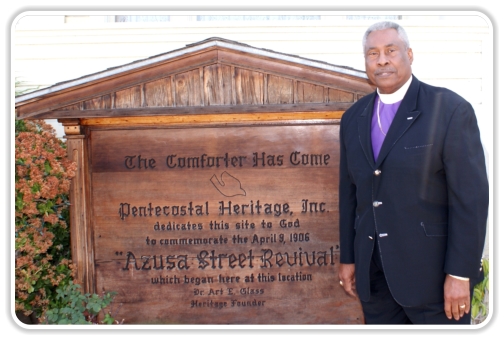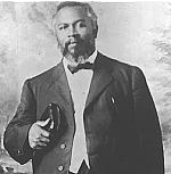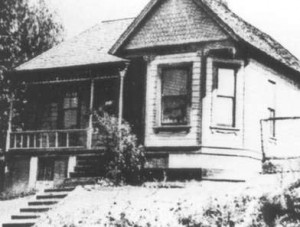
The Welsh Revival
 In 1905, William J. Seymour, the one-eyed 34 year old son of former slaves, was a student of well-known Pentecostal preacher Charles Parham and an interim pastor for a small holiness church in Houston, Texas. Neely Terry, an African American woman who attended a small holiness church pastored by Julia Hutchins in Los Angeles, made a trip to visit family in Houston late in 1905. While in Houston, she visited Seymour’s church, where he preached the baptism of the Holy Spirit with the evidence of speaking in tongues, and though he had not experienced this personally, Terry was impressed with his character and message. Once home in California, Terry suggested that Seymour be invited to speak at the local church. Seymour received and accepted the invitation in February 1906, and he received financial help and a blessing from Parham for his planned one-month visit.
In 1905, William J. Seymour, the one-eyed 34 year old son of former slaves, was a student of well-known Pentecostal preacher Charles Parham and an interim pastor for a small holiness church in Houston, Texas. Neely Terry, an African American woman who attended a small holiness church pastored by Julia Hutchins in Los Angeles, made a trip to visit family in Houston late in 1905. While in Houston, she visited Seymour’s church, where he preached the baptism of the Holy Spirit with the evidence of speaking in tongues, and though he had not experienced this personally, Terry was impressed with his character and message. Once home in California, Terry suggested that Seymour be invited to speak at the local church. Seymour received and accepted the invitation in February 1906, and he received financial help and a blessing from Parham for his planned one-month visit.
Los Angeles
Seymour arrived in Los Angeles on February 22, 1906, and within two days was preaching at Julia Hutchins’ church at the corner of Ninth Street and Santa Fe Avenue. During his first sermon, he preached that speaking in tongues was the first biblical evidence of the inevitable baptism in the Holy Spirit. On the following Sunday, March 4, he returned to the church and found that Hutchins had padlocked the door. Elders of the church rejected Seymour’s teaching, primarily because he had not yet experienced the blessing about which he was preaching. Condemnation of his message also came from the Holiness Church Association of Southern California with which the church had affiliation. However, not all members of Hutchins’ church rejected Seymour’s preaching. He was invited to stay in the home of congregation member Edward S. Lee, and he began to hold Bible studies and prayer meetings there.
The House on Bonnie Brae Street
 Seymour and his small group of new followers soon relocated to the home of Richard and Ruth Asberry at 214 North Bonnie Brae Street. White families from local holiness churches began to attend as well. The group would get together regularly and pray to receive the baptism of the Holy Spirit. On April 9, 1906, after five weeks of Seymour’s preaching and prayer, and three days into an intended 10-day fast, Edward S. Lee spoke in tongues for the first time. At the next meeting, Seymour shared Lee’s testimony and preached a sermon on Acts 2:4 and soon six others began to speak in tongues as well, including Jennie Moore, who would later become Seymour’s wife. A few days later, on April 12, Seymour spoke in tongues for the first time after praying all night long.
Seymour and his small group of new followers soon relocated to the home of Richard and Ruth Asberry at 214 North Bonnie Brae Street. White families from local holiness churches began to attend as well. The group would get together regularly and pray to receive the baptism of the Holy Spirit. On April 9, 1906, after five weeks of Seymour’s preaching and prayer, and three days into an intended 10-day fast, Edward S. Lee spoke in tongues for the first time. At the next meeting, Seymour shared Lee’s testimony and preached a sermon on Acts 2:4 and soon six others began to speak in tongues as well, including Jennie Moore, who would later become Seymour’s wife. A few days later, on April 12, Seymour spoke in tongues for the first time after praying all night long.
News of the events at North Bonnie Brae St. quickly circulated among the African American, Latino and White residents of the city, and for several nights, various speakers would preach to the crowds of curious and interested onlookers from the front porch of the Asberry home. Members of the audience included people from a broad spectrum of income levels and religious backgrounds. Hutchins eventually spoke in tongues as her whole congregation began to attend the meetings. Soon the crowds became very large and were full of people speaking in tongues, shouting, singing and moaning. Finally, the front porch collapsed, forcing the group to begin looking for a new meeting place. A resident of the neighborhood described the happenings at 214 North Bonnie Brae with the following words:
They shouted three days and three nights. It was Easter season. The people came from everywhere. By the next morning there was no way of getting near the house. As people came in they would fall under God’s power; and the whole city was stirred. They shouted until the foundation of the house gave way, but no one was hurt.
